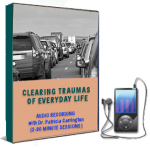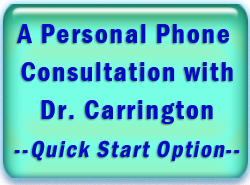Home » EFT Articles » EFT for Trauma / PTSD » Using EFT On-the-Spot for an Accident (Article)
Using EFT On-the-Spot for an Accident (Article)
By Dr. Patricia Carrington
I consider the use of EFT on-the-spot to handle emergencies to have enormous potential. If we use it right while the emergency is still occurring or directly afterwards while still at the scene of the trauma, this could forestall post traumatic stress disorder by nipping it in the bud, a highly desirable outcome.
However, it seems that most of the time people tell us how they used EFT to clear a past trauma, or used it
|
Gary Craig's Introduction:
I urge every serious EFT student to study this case carefully. It displays not only the power of EFT to collapse a traumatic incident "on-the-spot" (invaluable for terrorist victims) but it also introduces another highly useful way to "get even more specific" and thus increase the probability of complete resolution of the trauma. There must be some synchronicity in the air as I just introduced this "get even more specific" idea to a group of experienced EFT'ers in my home last week. The basic idea is to break down the traumatic event into its sensory sub-modalities (NLP term). This means to use EFT on the individual SIGHTS, SOUNDS and FEELINGS within the memory until they no longer carry a charge. Since they are often the building blocks of the memory itself, it is easy to see how neutralizing those with EFT can be an essential piece of EFT's application. A thank you to Rehana Webster from New Zealand and EFT Contributing Editor Patricia Carrington, PhD for bringing us Rehana's harrowing experience and the innovative way it was handled. Here's how Rehana described the trauma after applying EFT to it…. In fact I can barely recall any of the shock I felt then, and it is as though the accident happened many years ago instead of last week. The memory of it seems faded and far away. |
to handle ongoing personality difficulties or physical conditions, or in anticipation of an anxiety producing situation. On-the-spot use of EFT is of course also reported, but seemingly less often, perhaps because the many times we do use it in this way, as for example when we're in a dentist's chair, are so obvious that they don't seem noteworthy. People tell about and write about these less often.
I would like to see us be able to extract some recognizable principles for applying EFT under emergency conditions such as that occur during wartime, or during natural disasters. A simple, easily remembered protocol for such situations might forestall many serious problems.
To shed some light on this, I am a submitting a report sent to me by Rehana Webster, the New Zealand EFT practitioner whom you may remember for her outstanding write-up on the use of EFT with recidivist prisoners. She now describes an accident she was in that could have been fatal for her and how her immediate use of EFT, right on the scene, averted what could have become a strong post traumatic reaction.
I find particularly interesting the fact that she systematically handled residual distress in ALL of her major senses — visual, auditory and kinesthetic, and then dealt with some cognitive factors such as alarming self statements about how the accident could have been fatal, etc. Systematically forcing herself to go through all the different senses when under pressure, and presumably when she was not at her intellectual best, was clearly effective.
It may be that this approach can be useful to others as well. Instead of having to think about how to handle an ongoing (or just having occurred) crisis is hard to do if one is in a somewhat dazed state It could be a great help if the person didn't have to figure out what to tap on but simply remembered to ask themselves what VISUAL aspects of the scene are particularly distressing, and then what SOUNDS seem shocking to them to recall, and then what physical SENSATIONS they experienced that were distressing. This could provide a framework for handling the trauma, and help the person to process many of the aspects of the traumatic event which they might neglect if they were too general in their approach (which is always a temptation when under pressure).
GC COMMENT: Excellent idea!! To take apart a memory and separate it into its sensory features allows us to get very specific. Even though it may take a little more time to do, it increases the odds of complete resolution of the problem.
PAT CONTINUES: Here is how Rehana handled the immediate aftermath of her accident.
|
$37.00 |
On Tuesday March 11th, I was in a horrific car accident and came within a nanosecond of being killed (decapitated). I was playing the tourist guide for my friend Jon who had just arrived from LA. We were driving around looking at some property in the country.
At lunch time we stopped in the small town of Huntley on the Waikato River. It was a dismal day, gray, wet and blustery so we parked the car in front of a store and peered from the car to see if we could spot a restaurant close by.
Everything appeared normal. I looked in the mirrors to make sure it was safe before moving the car and waited for a large truck to pass us. A split second before it thundered past, there was a terrifying explosion like a bomb going off and my car was flung forward with a tremendous jolt. Simultaneously the windows imploded, shattering inward and showering Jon and myself with glass. There was this strange silence like a moment frozen in time. The glass shards were everywhere. There were powdery bits that seemed to get into my eyes and nose and larger bits that stuck in my hair and skin.
It was like being in a slow motion movie as I watched the truck hurtle past my car with an eight foot metal attachment swinging wildly from the back it. Apparently the flatbed truck, which was carrying a bobcat in a large cage, did not have the cage door secured, and as it passed, the gate had swung open with its iron door swinging like a giant shovel and literally wiping out both the back and the driver's side of my car–windows plus doors, and the car's roof.
I sat there feeling stunned, as if I had hit a brick wall with full impact, trying to take it all in until Jon came to his senses and got us out of the car. It all seemed like a dream, actually a nightmare. My brain felt numb and foggy. We viewed the damage and realized how close I came to losing my head! The gate had narrowly missed hitting my head by 6 inches or less. It was at the same height as my head and had swung past it, knocking out the back and side windows plus the supports which hold up the roof of the car. I felt like I had been hit over the head with a sledge hammer, the result of the shock waves produced by the imploding windows. It seemed very much like an explosive device, bomb or dynamite going off in my close vicinity.
Anyway, the cops were called and while we waited I took the opportunity to tap. I ran the whole event like a movie in my head, recalling the visual, auditory and kinesthetic sub-modalities of the incident [GC: sub-modalities is an NLP term for the building blocks of our sensory experience. It includes things like size, color, loudness, etc.]. The things that really stood out in my mind as I tapped were:
The gray wet weather (typical in New Zealand),
The beat-up old truck,
The BOOMING sound and earthshaking thud,
The implosion of the car windows,
The stinging of little pieces of glass in my neck, head, hair, face and the prickly feeling of the glass falling down my collar and back.
I also tapped on the 'could have been' aspects as well. I was amazed at the results. Not a twitch of fear as I recalled the accident. People were telling me that it was delayed shock. Well, I drove the next day…no jitters, and here it is more than a week later and certainly no sign of delayed shock. In fact I can barely recall any of the shock I felt then, and it is as though the accident happened many years ago instead of last week. The memory of it seems faded and far away.
Rehana Webster, BSc – http://www.behaviourchanges.com
EFT Master, Dr. Patricia Carrington



